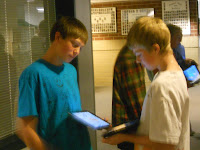La Cita Romántica De Tim Tebow Y Ani





Habia
Estaban en ....
Estaban en ....
Estaban en ...
Goal: to maximize repetitions of vocab structures used in stories in class, by having students review and think about meanings outside of class.
Objective: The students will use pictures from our class stories to retell (in Spanish) our story from class (aloud) using key vocab to a parent.
ISTE NETS in green
I HATE busy work. I think all teachers do, because we get our fair share of it. Don't get me wrong, I'm more than happy to do anything that will help me do my job better, but I can't stand when I'm made to spend time on something that will NOT impact me as a Spanish teacher in any way, shape, or form. Because of this, I also really try not to make my students do anything that will not later help them to speak, read, and write better in Spanish.
Back before I saw the light (when I taught traditionally instead of TPRS), my homework was often conjugating a long list of infinitives into whatever tense we were currently "learning." OR even better, a worksheet that had them rewriting sentences that required them matching the given subject to the appropriately conjugated verb. Usually, students would all copy the 2 kids that actually did the work right before the bell and, of course, none of the students had any idea what the sentences actually meant. They were just completing a pattern. I might as well have given them a fill in the blanks worksheet that looked like this:
Back before I saw the light (when I taught traditionally instead of TPRS), my homework was often conjugating a long list of infinitives into whatever tense we were currently "learning." OR even better, a worksheet that had them rewriting sentences that required them matching the given subject to the appropriately conjugated verb. Usually, students would all copy the 2 kids that actually did the work right before the bell and, of course, none of the students had any idea what the sentences actually meant. They were just completing a pattern. I might as well have given them a fill in the blanks worksheet that looked like this:
□ ◊ O □ ◊ O □ __ O □ ◊ O __ ◊ O □ ◊ __
I have found a homework activity that has proven to be very impactful...
I have found a homework activity that has proven to be very impactful...
So, now that I am following the TPRS model, I obviously have thrown out any of those old homework assignments. One activity that I am occasionally using as homework has proven VERY effective and beneficial for those students that actually do it. (Alas, They are still teenagers and sadly some of them don't care about learning Spanish nearly as much as I do!)
I post the pictures from our stories on our class edmodo page (Communication & Collaboration) and assign that students use the pictures to guide them as they re-tell our story (Critical Thinking, Problem Solving, Decision Making) to a parent, guardian, study hall teacher, etc. In order to get credit for this assignment, students must bring in a signed note telling me that they retold the story in Spanish.
Now, I know that I am not hearing them tell the story and I have no idea whether they use correct pronunciation, intonation, use the wrong conjugation of the verb, etc...NOR DO I CARE! My goal here is that the students understand the overall meaning of the words and take some risks and at least attempt using the words. This is a formative activity and it is not my expectation that they students have fully mastered speaking with this vocabulary; only that they are on their way to mastery. I usually follow up by beginning the next class by showing the story again and having volunteers tell a section of the story for an official speaking assessment and, without fail, the students that turn in the note that they practiced at home, are WAY more successful that the students who did not do the homework....SHOCKING, I know.
I use the app storykit and post on edmodo, which seems to be a good method; however the format or specific app(s) used is irrelevant. It's the process of giving the students exposure to the pictures and vocabulary again and forcing them to think about the meanings of the structures that makes this activity so successful.
Here is a link to an example of what the stories look like:
Awesome added bonus: In addition to the students getting more exposure and practice with the new vocab structures, most of the parents LOVE getting to hear what their kids are learning in class.



























